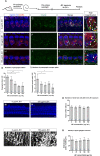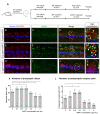Insulin-Like Growth Factor 1 on the Maintenance of Ribbon Synapses in Mouse Cochlear Explant Cultures
- PMID: 33132846
- PMCID: PMC7579230
- DOI: 10.3389/fncel.2020.571155
Insulin-Like Growth Factor 1 on the Maintenance of Ribbon Synapses in Mouse Cochlear Explant Cultures
Abstract
Hearing loss has become one of the most common disabilities worldwide. The synaptic connections between inner hair cells (IHCs) and spiral ganglion neurons have specialized synaptic constructions, termed ribbon synapses, which are important for auditory function. The ribbon synapses in the cochlea are quite vulnerable to various insults. As such, the maintenance of ribbon synapses is important for ensuring hearing function. Insulin-like growth factor 1 (IGF1) plays a critical role in the development and maintenance of the cochlea and has the potential to protect cochlear hair cells from various insults. In this study, we examined the role of IGF1 in the maintenance of ribbon synapses in cochlear explants of postnatal day four mice. We cultured cochlear explants with an IGF1 receptor antagonist, JB1, which is an IGF1 peptide analog. Results showed that exposure to JB1 for 24 h resulted in the loss of ribbon synapses. After an additional 24-h culture without JB1, the number of ribbon synapses spontaneously recovered. The application of exogenous IGF1 showed two different aspects of ribbon synapses. Low doses of exogenous IGF1 promoted the recovery of ribbon synapses, while it compromised the spontaneous recovery of ribbon synapses at high doses. Altogether, these results indicate that the paracrine or autocrine release of IGF1 in the cochlea plays a crucial role in the maintenance of cochlear ribbon synapses.
Keywords: cochlea; inner hair cell; insulin-like growth factor 1; maintenance; ribbon synapse.
Copyright © 2020 Gao, Kita, Katsuno, Yamamoto, Omori and Nakagawa.
Figures



Similar articles
-
Insulin-like growth factor 1 promotes cochlear synapse regeneration after excitotoxic trauma in vitro.Hear Res. 2019 Mar 15;374:5-12. doi: 10.1016/j.heares.2019.01.008. Epub 2019 Jan 17. Hear Res. 2019. PMID: 30682699
-
Autophagy is Required for Remodeling in Postnatal Developing Ribbon Synapses of Cochlear Inner Hair Cells.Neuroscience. 2020 Apr 1;431:1-16. doi: 10.1016/j.neuroscience.2020.01.032. Epub 2020 Feb 4. Neuroscience. 2020. PMID: 32032574
-
Local delivery of soluble fractalkine (CX3CL1) peptide restores ribbon synapses after noise-induced cochlear synaptopathy.Front Cell Neurosci. 2024 Oct 30;18:1486740. doi: 10.3389/fncel.2024.1486740. eCollection 2024. Front Cell Neurosci. 2024. PMID: 39539341 Free PMC article.
-
Protection of Cochlear Ribbon Synapses and Prevention of Hidden Hearing Loss.Neural Plast. 2020 Nov 1;2020:8815990. doi: 10.1155/2020/8815990. eCollection 2020. Neural Plast. 2020. PMID: 33204247 Free PMC article. Review.
-
Current concepts in cochlear ribbon synapse formation.Synapse. 2019 May;73(5):e22087. doi: 10.1002/syn.22087. Epub 2019 Feb 18. Synapse. 2019. PMID: 30592086 Free PMC article. Review.
Cited by
-
Prevention of Noise-Induced Hearing Loss In Vivo: Continuous Application of Insulin-like Growth Factor 1 and Its Effect on Inner Ear Synapses, Auditory Function and Perilymph Proteins.Int J Mol Sci. 2022 Dec 24;24(1):291. doi: 10.3390/ijms24010291. Int J Mol Sci. 2022. PMID: 36613734 Free PMC article.
-
Neuroprotective role of insulin-like growth factor 1 in auditory and other nervous systems.Histol Histopathol. 2022 Jul;37(7):609-619. doi: 10.14670/HH-18-437. Epub 2022 Feb 16. Histol Histopathol. 2022. PMID: 35170014 Review.
-
mTOR Signaling in the Inner Ear as Potential Target to Treat Hearing Loss.Int J Mol Sci. 2021 Jun 14;22(12):6368. doi: 10.3390/ijms22126368. Int J Mol Sci. 2021. PMID: 34198685 Free PMC article. Review.
-
Ceramide Kinase Inhibition Blocks IGF-1-Mediated Survival of Otic Neurosensory Progenitors by Impairing AKT Phosphorylation.Front Cell Dev Biol. 2021 Jun 4;9:678760. doi: 10.3389/fcell.2021.678760. eCollection 2021. Front Cell Dev Biol. 2021. PMID: 34179008 Free PMC article.
-
Teprotumumab for Graves' orbitopathy and ototoxicity: moving problems from eyes to ears?J Endocrinol Invest. 2022 Jul;45(7):1455-1457. doi: 10.1007/s40618-022-01791-w. Epub 2022 Apr 11. J Endocrinol Invest. 2022. PMID: 35403994 No abstract available.
References
-
- Allahdadi K. J., de Santana T. A., Santos G. C., Azevedo C. M., Mota R. A., Nonaka C. K., et al. . (2019). IGF-1 overexpression improves mesenchymal stem cell survival and promotes neurological recovery after spinal cord injury. Stem Cell Res. Ther. 10:146. 10.1186/s13287-019-1223-z - DOI - PMC - PubMed
LinkOut - more resources
Full Text Sources
Research Materials
Miscellaneous

